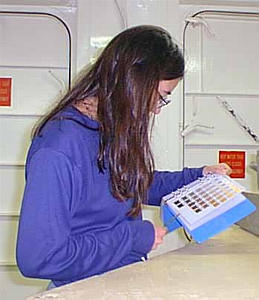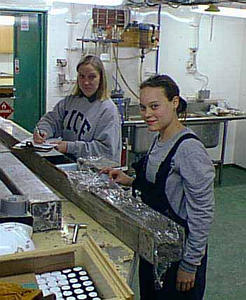20 February, 1999
February 20, 1999
Hello from the Ross Sea! Well, it wasn't as beautiful outside as it has been
-- in fact, it was really gray outside all day today. We had a great day
inside, however, and collected lots and lots of seismic data. The seismic
line
will continue tonight and into tomorrow. After that, we will be doing a
multibeam survey and taking some cores before we move out of the Ross Sea. I
can't believe how quickly the days are going! We've already been at sea for
over a week now . . . it's amazing. I'm really having a great time! I love
science, I love education, and I love exploring new places -- so what could be
better?
Due to the fact that we weren't taking any cores today, we had a little extra
time to finish analyzing yesterday's kasten cores. Yesterday's question was
"What types of things do you suppose we look at when we analyze the core?"
Some of the most important things are the color, the grain size, the amount
and
size of rocks or gravel, the boundaries between two different types of
sediments, and the amount of the mud's stiffness.
The first thing we do when we open up a kasten core is put a measuring tape
against the core and take pictures to document how the sediments looked before
they were disturbed. After that, we describe the color by using a small
spatula of mud and comparing the color changes to a color chart. Green mud
indicates that diatoms lived in the water above that mud. They sank to the
bottom after they died, and their color turned the sediments green. Diatoms
are algae that need sunlight to survive. They use sunlight as energy to make
their own food (like plants). When we find diatoms in the sediments, we know
that the area we are studying was NOT covered with ice when the diatoms were
living. Similarly, gray mud indicates an absence of diatoms . . . which could
mean that there was no sunlight . . . which could indicate that the area was
covered by ice (perhaps an ice shelf) at that point in history. Scientists
can
take a core of sediments, have the layers dated (we know the oldest layers are
on the bottom, but they want more exact dates), and use this information to
help figure out the glacial history of the area.
Sometimes, the sediments found in the cores contain small rocks. These rocks
are evidence that an ice sheet used to be nearby. Rocks can be picked up
by an
ice sheet and become frozen in the ice. Once the ice sheet reaches the coast,
icebergs calve off. The icebergs begin to melt, and the rocks drop to the
bottom of the ocean. We call these rocks dropstones. In other cores, the
sediments may contain a lot of ground up rock material that could have been
formed directly beneath the ice sheet as rocks were crushed and pulverized
under its heavy weight. Sediments formed like that are called glacial till.
After we are done describing the core, we take a mini-core to send back to the
United States for further analysis. In order to do this, we use a piece of
PVC
pipe that is sliced in half (lengthwise). We put the open side of the pipe on
top of the sediments and push down very hard. By using piano wire to slice
the
mud before we slowly turn the pipe over, we can then get a good sample of the
sediments to archive. We cover the pipe with plastic wrap and a thin piece of
plywood, using strong tape to make sure that they are firmly bound together.
These subcores are then labeled and tested for magnetic susceptibility before
they are put in the cooler with the piston and trigger cores. The remaining
kasten core sediments are then sampled for individual research projects. Some
samples are taken for analysis at Rice University and Florida State
University. Broxton takes samples in order to test the water content of the
sediments. Diane and PJ are looking for microscopic plants and animals. Once
everyone has taken everything that they need from the core, the core barrel is
thoroughly washed out so that it is ready to use again. The whole process
takes two to three hours.
I've had several questions about how we know our exact location when we can't
even see the land. What methods could we use to determine our location? How
do these methods compare to what the earliest Antarctic explorers used? We'll
look at that in tomorrow's journal. Don't forget . . . if you have any
questions, you are more than welcome to email them to me!
Kim Giesting
Latitude: 77 degrees 41 minutes South
Longitude: 162 degrees 54 minutes West
Temperature: - 0.8 degrees C
Barometer: 987.5 mb
Wind speed: 18 knots
Wind direction: 339 degrees (0 = north; 90 = east; 180 = south; 270 = west)
A wind direction of 339 degrees means that the wind is coming from the
northwest.

Tamara is using a color chart to determine the exact color of the sediments.

The kasten core is on its way down!

Julia and Hannah are describing the kasten core.
Contact the TEA in the field at
.
If you cannot connect through your browser, copy the
TEA's e-mail address in the "To:" line of
your favorite e-mail package.
|
